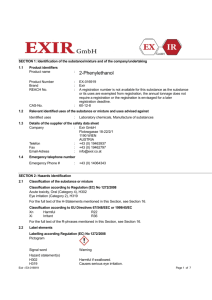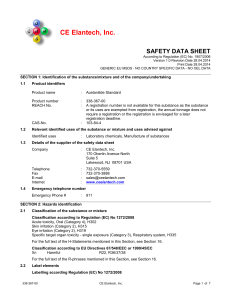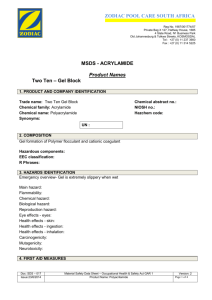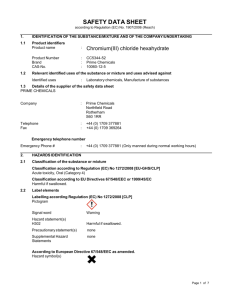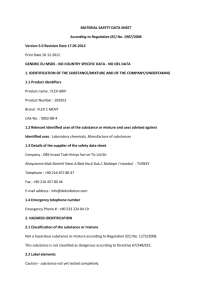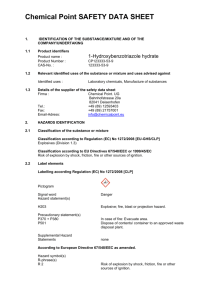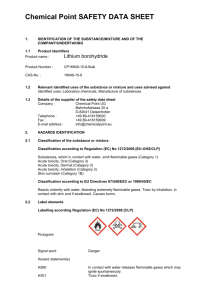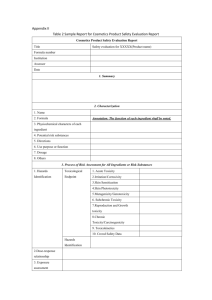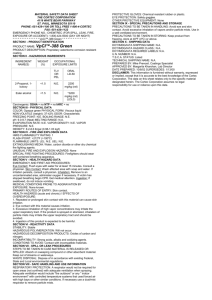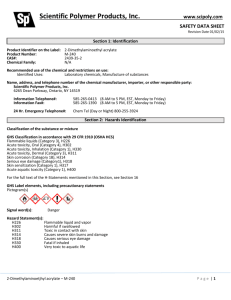Safety Data Sheet
advertisement
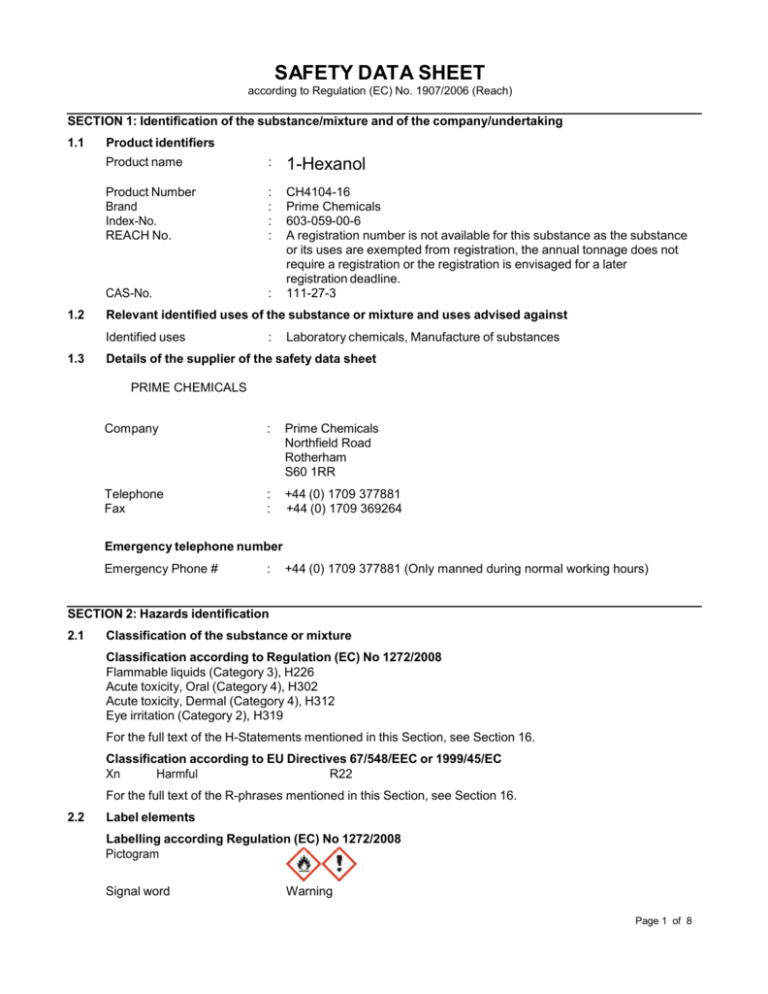
SAFETY DATA SHEET according to Regulation (EC) No. 1907/2006 (Reach) SECTION 1: Identification of the substance/mixture and of the company/undertaking 1.1 1.2 Product identifiers Product name : 1-Hexanol Product Number Brand Index-No. REACH No. : : : : CAS-No. : CH4104-16 Prime Chemicals 603-059-00-6 A registration number is not available for this substance as the substance or its uses are exempted from registration, the annual tonnage does not require a registration or the registration is envisaged for a later registration deadline. 111-27-3 Relevant identified uses of the substance or mixture and uses advised against Identified uses 1.3 : Laboratory chemicals, Manufacture of substances Details of the supplier of the safety data sheet PRIME CHEMICALS Company : Prime Chemicals Northfield Road Rotherham S60 1RR Telephone Fax : : +44 (0) 1709 377881 +44 (0) 1709 369264 Emergency telephone number Emergency Phone # : +44 (0) 1709 377881 (Only manned during normal working hours) SECTION 2: Hazards identification 2.1 Classification of the substance or mixture Classification according to Regulation (EC) No 1272/2008 Flammable liquids (Category 3), H226 Acute toxicity, Oral (Category 4), H302 Acute toxicity, Dermal (Category 4), H312 Eye irritation (Category 2), H319 For the full text of the H-Statements mentioned in this Section, see Section 16. Classification according to EU Directives 67/548/EEC or 1999/45/EC Xn Harmful R22 For the full text of the R-phrases mentioned in this Section, see Section 16. 2.2 Label elements Labelling according Regulation (EC) No 1272/2008 Pictogram Signal word Warning Page 1 of 8 Hazard statement(s) H226 H302 + H312 H319 Flammable liquid and vapour. Harmful if swallowed or in contact with skin Causes serious eye irritation. Precautionary statement(s) P280 P305 + P351 + P338 Wear protective gloves/ protective clothing. IF IN EYES: Rinse cautiously with water for several minutes. Remove contact lenses, if present and easy to do. Continue rinsing. Supplemental Hazard Statements 2.3 none Other hazards - none SECTION 3: Composition/information on ingredients 3.1 Substances Synonyms : Hexyl alcohol Formula Molecular Weight CAS-No. EC-No. Index-No. : : : : : C6H14O 102.17 g/mol 111-27-3 203-852-3 603-059-00-6 Hazardous ingredients according to Regulation (EC) No 1272/2008 Component Classification Hexan-1-ol CAS-No. EC-No. Index-No. 111-27-3 203-852-3 603-059-00-6 Flam. Liq. 3; Acute Tox. 4; Eye <= 100 % Irrit. 2; H226, H302 + H312, H319 Hazardous ingredients according to Directive 1999/45/EC Component Classification Hexan-1-ol CAS-No. EC-No. Index-No. 111-27-3 203-852-3 603-059-00-6 Concentration Xn, R22 Concentration <= 100 % For the full text of the H-Statements and R-Phrases mentioned in this Section, see Section 16 SECTION 4: First aid measures 4.1 Description of first aid measures General advice Consult a physician. Show this safety data sheet to the doctor in attendance. If inhaled If breathed in, move person into fresh air. If not breathing, give artificial respiration. Consult a physician. In case of skin contact Wash off with soap and plenty of water. Consult a physician. In case of eye contact Rinse thoroughly with plenty of water for at least 15 minutes and consult a physician. If swallowed Do NOT induce vomiting. Never give anything by mouth to an unconscious person. Rinse mouth with water. Consult a physician. Page 2 of 8 4.2 Most important symptoms and effects, both acute and delayed The most important known symptoms and effects are described in the labelling (see section 2.2) and/or in section 11 4.3 Indication of any immediate medical attention and special treatment needed no data available SECTION 5: Firefighting measures 5.1 Extinguishing media Suitable extinguishing media Use water spray, alcohol-resistant foam, dry chemical or carbon dioxide. 5.2 Special hazards arising from the substance or mixture Carbon oxides 5.3 Advice for firefighters Wear self contained breathing apparatus for fire fighting if necessary. 5.4 Further information Use water spray to cool unopened containers. SECTION 6: Accidental release measures 6.1 Personal precautions, protective equipment and emergency procedures Use personal protective equipment. Avoid breathing vapours, mist or gas. Ensure adequate ventilation. Remove all sources of ignition. Beware of vapours accumulating to form explosive concentrations. Vapours can accumulate in low areas. For personal protection see section 8. 6.2 Environmental precautions Prevent further leakage or spillage if safe to do so. Do not let product enter drains. Discharge into the environment must be avoided. 6.3 Methods and materials for containment and cleaning up Contain spillage, and then collect with an electrically protected vacuum cleaner or by wet-brushing and place in container for disposal according to local regulations (see section 13). 6.4 Reference to other sections For disposal see section 13. SECTION 7: Handling and storage 7.1 Precautions for safe handling Avoid contact with skin and eyes. Avoid inhalation of vapour or mist. Keep away from sources of ignition - No smoking.Take measures to prevent the build up of electrostatic charge. For precautions see section 2.2. 7.2 Conditions for safe storage, including any incompatibilities Store in cool place. Keep container tightly closed in a dry and well-ventilated place. Containers which are opened must be carefully resealed and kept upright to prevent leakage. 7.3 Specific end use(s) Apart from the uses mentioned in section 1.2 no other specific uses are stipulated SECTION 8: Exposure controls/personal protection 8.1 Control parameters Components with workplace control parameters Contains no substances with occupational exposure limit values. Page 3 of 8 8.2 Exposure controls Appropriate engineering controls Handle in accordance with good industrial hygiene and safety practice. Wash hands before breaks and at the end of workday. Personal protective equipment Eye/face protection Face shield and safety glasses Use equipment for eye protection tested and approved under appropriate government standards such as NIOSH (US) or EN 166(EU). Skin protection Handle with gloves. Gloves must be inspected prior to use. Use proper glove removal technique (without touching glove's outer surface) to avoid skin contact with this product. Dispose of contaminated gloves after use in accordance with applicable laws and good laboratory practices. Wash and dry hands. The selected protective gloves have to satisfy the specifications of EU Directive 89/686/EEC and the standard EN 374 derived from it. Full contact Material: Nitrile rubber Minimum layer thickness: 0.4 mm Break through time: 480 min Material tested:Camatril® (KCL 730 / Aldrich Z677442, Size M) Splash contact Material: Nitrile rubber Minimum layer thickness: 0.2 mm Break through time: 30 min Material tested:Dermatril® P (KCL 743 / Aldrich Z677388, Size M) data source: KCL GmbH, D-36124 Eichenzell, phone +49 (0)6659 87300, e-mail sales@kcl.de, test method: EN374 If used in solution, or mixed with other substances, and under conditions which differ from EN 374, contact the supplier of the CE approved gloves. This recommendation is advisory only and must be evaluated by an industrial hygienist and safety officer familiar with the specific situation of anticipated use by our customers. It should not be construed as offering an approval for any specific use scenario. Body Protection Complete suit protecting against chemicals, Flame retardant antistatic protective clothing, The type of protective equipment must be selected according to the concentration and amount of the dangerous substance at the specific workplace. Respiratory protection Where risk assessment shows air-purifying respirators are appropriate use a full-face respirator with multi-purpose combination (US) or type ABEK (EN 14387) respirator cartridges as a backup to engineering controls. If the respirator is the sole means of protection, use a full-face supplied air respirator. Use respirators and components tested and approved under appropriate government standards such as NIOSH (US) or CEN (EU). Control of environmental exposure Prevent further leakage or spillage if safe to do so. Do not let product enter drains. Discharge into the environment must be avoided. SECTION 9: Physical and chemical properties 9.1 Information on basic physical and chemical properties a) Appearance Form: clear, liquid Colour: colourless b) Odour no data available c) Odour Threshold no data available Page 4 of 8 9.2 d) pH no data available e) Melting point/freezing point Melting point/range: -52 °C - lit. f) Initial boiling point and boiling range 156 - 157 °C - lit. g) Flash point no data available h) Evapouration rate no data available i) Flammability (solid, gas) no data available j) Upper/lower flammability or explosive limits Lower explosion limit: 1.3 %(V) k) Vapour pressure 1.00 hPa at 20 °C 1 hPa at 25.6 °C l) Vapour density 3.53 - (Air = 1.0) m) Relative density 0.814 g/cm3 at 25 °C n) Water solubility no data available o) Partition coefficient: noctanol/water log Pow: 1.82 p) Auto-ignition temperature no data available q) Decomposition temperature no data available r) Viscosity no data available s) Explosive properties no data available t) Oxidizing properties no data available Other safety information Relative vapour density 3.53 - (Air = 1.0) SECTION 10: Stability and reactivity 10.1 Reactivity no data available 10.2 Chemical stability Stable under recommended storage conditions. 10.3 Possibility of hazardous reactions no data available 10.4 Conditions to avoid Heat, flames and sparks. 10.5 Incompatible materials Strong oxidizing agents, Strong acids 10.6 Hazardous decomposition products Other decomposition products - no data available In the event of fire: see section 5 Page 5 of 8 SECTION 11: Toxicological information 11.1 Information on toxicological effects Acute toxicity LD50 Oral - rat - 720 mg/kg Remarks: Liver:Fatty liver degeneration. Kidney, Ureter, Bladder:Other changes. Blood:Other changes. LD50 Dermal - rabbit - male - 1,500 mg/kg Skin corrosion/irritation Skin - rabbit Result: Mild skin irritation Serious eye damage/eye irritation Eyes - rabbit Result: Irritating to eyes. Respiratory or skin sensitisation no data available Germ cell mutagenicity Result: Not mutagenic in Ames Test. Histidine reversion (Ames) Carcinogenicity IARC: No component of this product present at levels greater than or equal to 0.1% is identified as probable, possible or confirmed human carcinogen by IARC. Reproductive toxicity no data available Specific target organ toxicity - single exposure no data available Acute dermal toxicity - Diarrhoea, Loss of reflexes, Coma, Rapid respiration Specific target organ toxicity - repeated exposure no data available Aspiration hazard no data available Additional Information RTECS: MQ4025000 Dermatitis, Nausea, Dizziness, Headache, narcosis, To the best of our knowledge, the chemical, physical, and toxicological properties have not been thoroughly investigated. SECTION 12: Ecological information 12.1 Toxicity Toxicity to fish LC50 - Pimephales promelas (fathead minnow) - 97.7 mg/l - 96 h Toxicity to daphnia and other aquatic invertebrates EC50 - Daphnia magna (Water flea) - > 100 mg/l - 24 h 12.2 Persistence and degradability Biodegradability Result: > 70 % - Readily biodegradable. 12.3 Bioaccumulative potential Bioaccumulation Oncorhynchus mykiss (rainbow trout) - 24 h - 39,800 µg/l Bioconcentration factor (BCF): 0.5 Page 6 of 8 12.4 Mobility in soil no data available 12.5 Results of PBT and vPvB assessment PBT/vPvB assessment not available as chemical safety assessment not required/not conducted 12.6 Other adverse effects Harmful to aquatic life. no data available SECTION 13: Disposal considerations 13.1 Waste treatment methods Product Burn in a chemical incinerator equipped with an afterburner and scrubber but exert extra care in igniting as this material is highly flammable. Offer surplus and non-recyclable solutions to a licensed disposal company. Contaminated packaging Dispose of as unused product. SECTION 14: Transport information 14.1 UN number ADR/RID: 2282 IMDG: 2282 IATA: 2282 14.2 UN proper shipping name ADR/RID: HEXANOLS IMDG: HEXANOLS IATA: Hexanols 14.3 Transport hazard class(es) ADR/RID: 3 IMDG: 3 IATA: 3 Packaging group ADR/RID: III IMDG: III IATA: III Environmental hazards ADR/RID: no IMDG Marine pollutant: no IATA: no 14.4 14.5 14.6 Special precautions for user no data available SECTION 15: Regulatory information This safety datasheet complies with the requirements of Regulation (EC) No. 1907/2006. 15.1 Safety, health and environmental regulations/legislation specific for the substance or mixture no data available 15.2 Chemical Safety Assessment For this product a chemical safety assessment was not carried out SECTION 16: Other information Full text of H-Statements referred to under sections 2 and 3. Acute Tox. Eye Irrit. Flam. Liq. H226 H302 H302 + H312 Acute toxicity Eye irritation Flammable liquids Flammable liquid and vapour. Harmful if swallowed. Harmful if swallowed or in contact with skin Page 7 of 8 H312 Harmful in contact with skin. Full text of R-phrases referred to under sections 2 and 3 Xn R22 Harmful Harmful if swallowed. Further information The above information is believed to be correct but does not purport to be all inclusive and shall be used only as a guide. The information in this document is based on the present state of our knowledge and is applicable to the product with regard to appropriate safety precautions. It does not represent any guarantee of the properties of the product. Page 8 of 8
